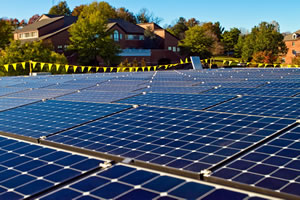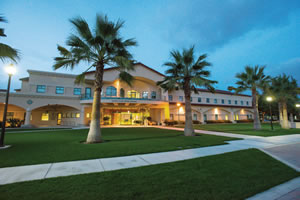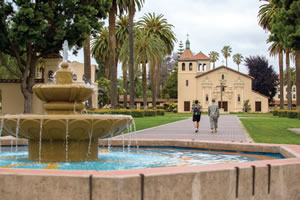Off the Grid

PHOTO COURTESY OF EASTERN MENNONITE UNIVERSITY
Microgrids are the future of energy distribution and colleges and universities are leading the way. Instead of relying on a remote power source, microgrids allow entities that are already co-generating electricity to create a resilient system independent of their utility. In some cases, they can sell extra energy back to the utility or negotiate lower rates year-round.
Microgrids may even make it possible to rely completely on renewable energy, according to “Renewable Energy 100: The Course to a Carbon-Free Campus” a report from Environment America Research & Policy Center. While 100-percent renewables — think solar, wind, biomass and algae — remains a far-reaching goal, the technology offers value right now.
But first, what is a microgrid? According to the Department of Energy, a microgrid is a local energy grid with control capability, which means it can disconnect from the traditional grid and operate autonomously. A microgrid, for the most part, operates while connected to traditional grid but can break off, or island itself, and operate on its own. It can be powered by distributed generators, batteries and renewable sources.
Three schools discuss how and why they started their microgrid projects.
Blackout? Brownout? Get Out!
As they essentially operate as small, independent cities, college campuses often generate and distribute a portion their own energy and rely on a utility to supply the rest. This works well… until it doesn’t. Disruptions to the central grid caused by storms, natural disasters, accidents or high demand will cut power, leaving large areas in the dark, sometimes for days at a time.

PHOTO COURTESY OF SANTA CLARA UNIVERSITY
LIGHT ME UP. Santa Clara University is on course to install a smart microgrid, which ties its power source, transmission, distribution and even consumption data to weather reports, thereby maximizing energy savings. In the first phase of the project, SCU installed sub-meters into 14 buildings and integrated the smart microgrid’s onsite alternative energy sources, such as solar, fuel cells and micro-turbines. The next phase will connect the entire campus to the microgrid. Once the launch of the smart microgrid is complete, it’s estimated to reduce energy consumption by 50 percent and save the university about 20 percent in energy costs.
“We have 21,000 students and 6,000 of them live on campus. We can’t just lose power,” according to Shawn Connolly, vice president for University Facilities, Montclair State University in Montclair, NJ. Along with students, campuses also host sensitive sites like science buildings with critical research and hospitals that can’t go dark. Microgrids allow campuses to keep operations going during an outage.
This kind of resiliency was the primary driver for Santa Clara University in Santa Clara, CA, to invest in their microgrid. They just completed phase one of the project. “It ensures business continuity,” explains Chris Watt, director of Utilities.
Spike the Rate Hike
Eastern Mennonite University in Harrisonburg, VA, has emphasized sustainability on campus for the last 30 years. They are presently in the design and specification stage of their microgrid and plan to install three 500kW natural gasfired generators to augment their existing 104 kW solar array. When completed later this year, the microgrid alone could power the school’s approximately 650,000 square feet of buildings.
But energy independence isn’t the school’s main driver. Instead, they’re interested in lower distribution demand charges.
“This project allows us to change our rate schedule with the local utility,” explains Director of Facilities Ed Lehman. He projects that the microgrid will save about $7.00 per kW on the distribution demand charge. “In addition, we benefit at a rate of $12.50 per kW reduced when we lower our power demand at times when the local utility is experiencing significant power demand and when their cost of power from the regional grid is the highest.”
Saving money also appealed to Connolly at Montclair State. The university’s 5.4 MW cogeneration plant went online in 2013, and met about 85 percent of their energy needs. Since then the school has added 350,000 square feet of buildings, widening that gap between what they produced and what they bought.
“I was particularly interested in the electricity we bought during the summer,” says Connolly. “That is the most expensive block.”

PHOTO COURTESY OF SANTA CLARA UNIVERSITY
Montclair will modify their substation and add 5 MW of gas generation. Connolly estimates that the new generator will run about 1,000 hours a year. The new system will allow the school to reduce demand during those peak, hot summer months when energy is most expensive.
Carbon Footprint
Colleges and universities have long been on the vanguard of using renewable energy. Microgrids make integrating these resources easier… eventually. “We presently have 1.2 MW of solar pv that makes up 8 percent of our total energy usage,” says Santa Clara’s Watt. What the school doesn’t have is on-site storage; a.k.a., a battery. “That’s phase three of the project.”
Lehman is open to adding different renewable sources like biomass or microturbines, and Connolly states that Montclair State’s 284 kW solar field won’t be their last. However, a smart microgrid with advanced controls makes natural gas, already low-priced and abundant, a more sustainable choice.
Next Steps
Both Connolly and Watt were facing the same issue when first exploring microgrid technology: aging campus infrastructure. Many electrical distribution components at Santa Clara were already at the end of their life. Montclair was limping along with a 100-year-old distributed steam system. Microgrids offered a forward-looking solution.
But schools shouldn’t move towards microgrids just because they can. “Don’t let ideology drive this decision,” warns Watt. Connolly agrees. He strongly urges talking to experts, modeling energy costs and bringing in independent third parties to “throw stones and find flaws. The more input and due diligence you do the less likely you are to build a system that doesn’t meet your needs or work financially.”
FOR THE GOOD OF ALL
The University of Wisconsin–Milwaukee (UWM) has joined a federally funded partnership of universities and companies working to make the U.S. electrical grid more reliable, greener and less expensive.
UWM recently announced its membership in a National Science Foundation-backed research center called “Grid-connected Advanced Power Electronic Systems,” or GRAPES, headquartered at the University of Arkansas (http://vtb.engr.sc.edu/GRAPES). The center partners with industry to develop new technologies for storing, controlling and distributing energy that are compatible with the existing electrical grid, can ward off cybersecurity threats and could lower energy bills.
UWM’s contribution to the center is its expertise in microgrids, which integrate energy from multiple, smaller sources, including renewables. While interest in microgrids started with the military, which has an interest in powering bases in isolated areas, it has grown as the costs of solar power and energy storage come down, says Adel Nasiri, associate dean for research and UWM professor of electrical engineering.
UWM faculty members are working with industry to commercialize microgrid technology and gain entry into a market that is projected to generate $1.6 billion in revenue in the next few years.
“By working with business and exchanging ideas, we each have a clearer line of sight between the research labs and consumer,” says Brett Peters, dean of UWM’s College of Engineering & Applied Science. “With that, we can solve today’s tough challenges efficiently.”
This article originally appeared in the issue of .